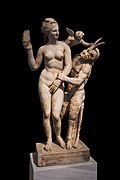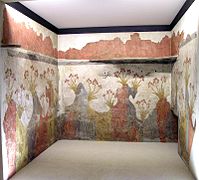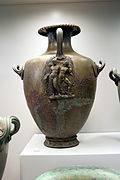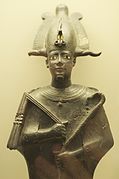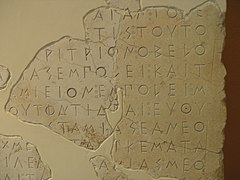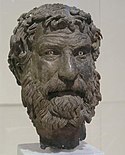Narodowe Muzeum Archeologiczne w Atenach
| Państwo | |
|---|---|
| Miejscowość | |
| Data założenia | 1829 |
| Zakres zbiorów | sztuka grecka od czasów prehistorycznych do późnego antyku |
| Wielkość zbiorów | ponad 20 tys. |
| Powierzchnia ekspozycji | ponad 8 tys. m² |
Położenie na mapie Grecji (c) Lencer, CC BY-SA 3.0 | |
| Strona internetowa | |
Narodowe Muzeum Archeologiczne w Atenach (gr. Εθνικό Αρχαιολογικό Μουσείο) – muzeum w Atenach, gromadzące zabytki archeologiczne z obszaru Grecji od czasów prehistorycznych do późnego antyku. Jest największym muzeum w Grecji oraz jednym z ważniejszych na świecie[1].
Historia
Pierwsze narodowe muzeum archeologiczne w Grecji zostało założone przez premiera Grecji Joanisa Kapodistriasa na Eginie w 1829. W kolejnych latach zbiory archeologiczne były przenoszone do różnych sal wystawowych aż do roku 1858, kiedy to został ogłoszony międzynarodowy konkurs na lokalizację i opracowanie koncepcji architektonicznej nowego muzeum[2].
Budowa obecnego muzeum rozpoczęła się w 1866 roku i została zakończona w 1889. Sfinansowano ją ze środków rządu greckiego, Greckiego Towarzystwa Archeologicznego i społeczeństwa Myken. Głównymi darczyńcami byli: Eleni Tositsa (przekazanie gruntów pod budowę muzeum) oraz Demetrios i Nikolaos Vernardakis z Petersburga, którzy wsparli budowę finansowo.
Początkowo muzeum nosiło nazwę Muzeum Centralne. Nazwa została zmieniona na obecną w 1881 roku przez premiera Grecji Charilaosa Trikupisa. Podczas II wojny światowej muzeum zamknięto, zaś eksponaty umieszczono w opieczętowanych skrzyniach i zakopano w celu uniknięcia ich zniszczenia i grabieży. W 1945 zbiory ponownie udostępniono.
W południowym skrzydle mieści się muzeum epigrafii z najbogatszą na świecie kolekcją inskrypcji. Muzeum inskrypcji rozbudowano w latach 1953-1960 według projektu Patroklosa Karantinosa[3].
Zbiory
Muzeum jest podzielone na działy:
- prehistoria (neolit, kultura cykladzka, kultura mykeńska)
- rzeźba (od epoki archaicznej VIII w. p.n.e. aż po hellenistyczną, III i II w p.n.e.)
- ceramika (od stylu geometrycznego IX w. p.n.e. do końca IV w. n.e.)
- odkrycia z Santorynu
- metalurgia
- sztuka starożytnego Egiptu
- starożytny Bliski Wschód
- osobny dział z eksponatami związanymi z wrakiem z Antykithiry, z oddzielną salą, poświęconą oryginałowi, modelom i multimedialnym prezentacjom mechanizmu zegara z Antykithiry
- Samodzielne mniejsze zbiory obejmują przedmioty z brązu, biżuterię oraz freski z wyspy Tira, które powstały pod silnym wpływem minojskim.
| Zbiory | ||
|---|---|---|
| Dział | Pomieszczenia | Wybrane obiekty |
| Prehistoria (Neolit, Cyklady, Kultura mykeńska) | 3–6, 48[4] |
|
| Rzeźby | 7–34 |
|
| Wazy i obiekty pochodzące z Kultury Minojskiej (w tym kolekcje: Stathatos i Vlastos-Serpieris) | 42[5], 49–56[6] |
|
| Santorini | 48 |
|
| Metalurgia | 36–39 |
|
| Sztuka Starożytnego Egiptu i Bliskiego Wschodu | 40–41 | |
| Muzeum Epigraficzne | 1, 9, 11 |
|
Przypisy
- ↑ Ministerstwo Kultury Grecji | Narodowe Muzeum Archeologiczne
- ↑ The National Archaeological Museum (2000) Euangelia Kypraiou Archaeological Receipts Fund Direction of Publications, Athens Greece
- ↑ http://www.cityofathens.gr/portal/site/AthensPortal/menuitem.d11c8c76b66cf1c27d4139c3500000a0/indexbb64.html
- ↑ The Prehistoric Collection. nam.culture.gr. [zarchiwizowane z tego adresu (2016-03-05)]., Narodowe Muzeum Archeologiczne w Atenach
- ↑ Stathatos Collection. odysseus.culture.gr. [zarchiwizowane z tego adresu (2016-01-21)]., National Archaeological Museum
- ↑ The Vase and Minor Objects Collection. odysseus.culture.gr. [zarchiwizowane z tego adresu (2016-09-20)]., Narodowe Muzeum Archeologiczne a Atenach
Media użyte na tej stronie
(c) Lencer, CC BY-SA 3.0
Location map of Greece
Equirectangular projection, N/S stretching 120 %. Geographic limits of the map:
- N: 42.0° N
- S: 34.6° N
- W: 19.1° E
- E: 29.9° E
Autor: unknown, Licencja: CC BY 2.5
Honorific decree with the inscription: “The deme Aixone honours the choregoi Auteas and Philoxenides”. White, medium-grained marble, 313–312 BC. Found in Glyphada in 1941.
Autor: unknown, Licencja: CC BY 2.5
Fresque du Printemps. C'est la seule fresque d'Akrotiri à avoir été trouvée in situ, couvrant trois murs de la même pièce. Elle dépeint un paysage rocheux de l'île, avant l'éruption volcanique : de petits groupes de lis rouges dominent les formations volcaniques rouges et grises, tandis que des hirondelles survolent la scène et annoncent symboliquement la renaissance annuelle de la nature. L'utilisation très riche des couleurs (blanc, rouge, jaune et bleu) et le mouvement créé par le balancement des fleurs dans le vent et le jeu des hirondelles permettent d'attribuer cette fresque au peintre des « Cueilleurs de Crocus ». La pièce avait une étagère, en hauteur sur un mur, et une ouverture menant à une pièce plus petite au nord. Le modèle en plâtre d'un lit provient aussi de cette pièce. Pièce D2, édifice D à Akrotiri.
Autor: Jebulon, Licencja: CC0
Aphrodite, Pan, Eros, NAMA 3335, Athens, Greece
Autor: Tilemahos Efthimiadis from Athens, Greece, Licencja: CC BY 2.0
Εθνικό Αρχαιολογική Μουσείο. Αθήνα.
Autor: Rosemania, Licencja: CC BY 2.0
Remarkable gold elliptical funeral diadems, leaves, wheels, cups, earrings, pendants and pins from Shaft Grave III, "Grave of the Women", Grave Circle A, Mycenae. 1600-1500 BC. National Archaeological Museum, Athens. Once part of a large cemetery outside the acropolis walls, Grave Circle A was discovered within the Mycenaean citadel by Heinrich Schliemann in 1876 under the supervision of the Greek Ephor of Antiquities Panagiotis Stamatakis.
The tombs in Grave Circle A contained a total of nineteen burials: nine males, eight females and two infants. With the exception of Grave II, which contained a single burial, all of the other graves contained between two and five inhumations.
The amazing wealth of the grave gifts reveals both the high social rank and the martial spirit of the deceased: gold jewelry and vases, a large number of decorated swords and other bronze objects, and artefacts made of imported materials, such as amber, lapis lazuli, faience and ostrich eggs. All of these, together with a small but characteristic group of pottery vessels, confirm Mycenae's importance during this period, and justify Homer's designation of Mycenae as 'rich in gold.'Autor: Giovanni Dall'Orto., Licencja: Attribution
Roman copy (ca. 160 AD), from a 4th century BC Greek original, of a statue of Asclepius, from the ghod's sanctuary in Epidauros. Exhibited in the National Archaeological Museum in Athens, Room 32. Picture by Giovanni Dall'Orto, November 11 2009.
Autor:
Shaft Grave V, Grave Circle A, Mycenae.
Found in Tomb V in Mycenae by Heinrich Schliemann in 1876.
Gold death-mask known as the "Mask of Agamemnon". This mask depicts the imposing face of a bearded noble man. It is made of a gold sheet with repoussé details. Two holes near the ears indicate that the mask was held in place of the deceased's face with twine. The authenticity of the mask has been formally questioned due to the high level of detail, such as the beard and ears. No other mask of its type has a similar amount of detail.Autor: Giovanni Dall'Orto., Licencja: Attribution
Bronze jar with applique showing drunken Dionysos leaning upon a satyr. Circa 400 BC. From a grave in Eretria, Euboea. On display in the Room 38 of the National Archaeological Museum in Athens. Picture by Giovanni Dall'Orto, November 11 2009.
Autor: Tilemahos Efthimiadis from Athens, Greece, Licencja: CC BY 2.0
5706. Table support with a Dionysiac group. Marble from Dokimeion in Asia Minor. Unknown provenance. This piece was the single support for a table top. The pillar-support is adorned by a group of Dionysos, Pan and a Satyr.
The nude Dionysos holds a rhyton (ritual vase) ending in the front half of a panther. Next to him the goat-footed god Pan holds a lagobolon (stick to hares). In front of him is a small cylindrical basket, from which a snake is emerging. A young Satyr climbs up the vine and cuts grapes with in his right hand. From the branch hangs a lagobolon, a pan-pipe and a goatskin. The exposed parts of the bodies are very well polished. Traces of red and yellow colour are preserved on the hair of the figures and the branches. This elaborate piece is from an Asia Minor workshop. AD 170-180. National Archaeological Museum, Athens, Greece --- 5706. Τραπεζοφόρο με διονυσιακό σύμπλεγμα. Μάρμαρο Δοκιμείου Μικράς Ασίας. Άγνωστης προέλευσης. Αποτελούσε το μονόποδο στήριγμα της πλάκας ενός τραπεζιού. Τον πεσσό-στήριγμα στολίζει σύμπλεγμα Διονύσου, Πανός και Σατύρου. Ο γυμνός Διόνυσος κρατεί ρυτόν (τελετουργικό αγγείο) που απολήγει σε ημίτομο πάνθηρα. Πλάι τou ο τραγοπόδαρος Παν κρατεί λαγωβόλο. Μπροστά του υπάρχει μια μικρή κυλινδρική κίαιην από όπου ξεπροβάλλει φίδι. Ο μίκρος Σάτυρος είναι οκαρφαλωμένος στην κληματαριά και, κρατώντας στο δεξί χέρι ένα δρεπάνι, κόβει σταφύλια. Από το κλαδί ένα λαγωβόλο, η σύριγγα του Πανός και μια δορά αίγας, Τα γυμνά μέρη των σωμάτων είναι πολύ καλά στιλβωμένα. Ίχνη κόκκινου και κίτρινου χρώματος οώζονται στα μαλλιά και στα κλαδιά. Το περίτεχνο έργο προέρχεται από μικρασιατικό εργαστήριο. 170-180 μ.Χ.
Εθνικό Αρχαιολογική Μουσείο. Αθήνα.Autor:
The oldest attic epigraphy from the Museum of Acropolis, dated from the eighth century AD-(rune script) Boustrophédon, two lines.
Ship procession fresco, part 1, Akrotiri, Greece.
Autor:
Athena Varvakeion, small Roman replica of the Athena Parthenos by Phidias. Found in Athens near the Varvakeion school, hence the name. First half of the 3rd c. AD.
Autor: Jebulon, Licencja: CC0
Ancient egyptian funerary mask. Cartonage.
Autor: Lucretius, Licencja: GFDL
The National Archaeological Museum of Athens, Greece
Autor: Tilemahos Efthimiadis from Athens, Greece, Licencja: CC BY 2.0
Egyptian collectible necklace on displayed in Athen’s National Archaeological Museum. Athena.
Autor: Giovanni Dall'Orto., Licencja: Attribution
The Antikythera Mechanism, a Hellenistic astronomical computer, on display in room 38 of the National Archaeological Museum in Athens. Picture by Giovanni Dall'Orto, November 11 2009.
Autor: Giovanni Dall'Orto., Licencja: Attribution
Bronze pitchers in the Room 38 of the National Archaeological Museum in Athens. Picture by Giovanni Dall'Orto, November 11 2009.
Chimera on vase at Athens Archelogical Museum
Autor: Aleksandr Zykov from Russia, Licencja: CC BY-SA 2.0
from egyptian art collection
Autor: Schuppi, Licencja: CC BY-SA 3.0
National Archaeological Museum of Athens: Golden cups from grave IV and V of grave circle A at Mykenae.
Autor: OpenStreetMap contributors, Licencja: CC BY-SA 2.0
OpenStreetMap map of Athens, Greece, intended for use in geolocation templates.
- top = 38.151
- bottom = 37.858
- left = 23.556
- right = 23.897
Autor:
Détail d'une partie de la loi sacrée sur l'Acropole et l'Hékatompédon. 485/4 av. J.-C.









